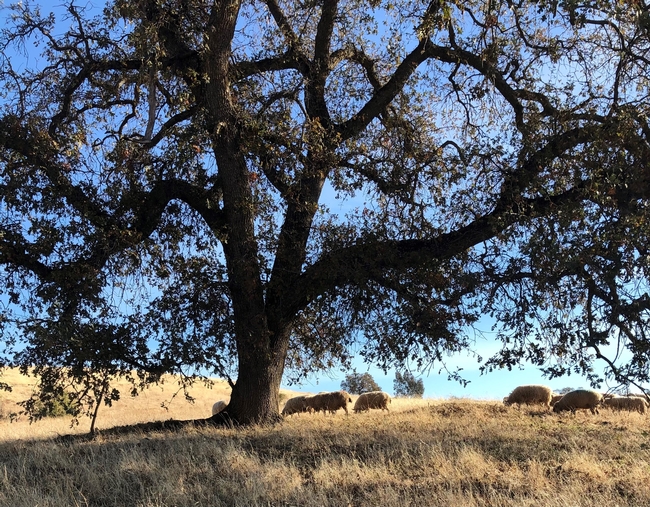When we finally received a more than two inches of rain in mid-November, I was relieved that we would finally have germination on our foothill rangelands - better late than never! Today, after two weeks of sunshine, I am indeed seeing a little green coming up through last year's dry forage. But the forecast isn't promising - as of this morning (November 30), we have no rain in our forecast here in Auburn for the next two weeks. The combination of dry weather, short days, and colder (for here, at least) temperatures indicates that we won't likely grow much grass during the month of December.
Drought planning begins with proactive strategies - a conservative stocking rate, for example, or a production calendar designed to match periods of high forage demand with rapid forage growth. One of the most important proactive strategies in our small-scale sheep operation is grazing planning. Over the years, we've trained our eyes to estimate the amount of forage we have available - measured in sheep days per acre. While our estimates are not 100 percent accurate all of the time, the simple act of looking ahead and estimating the quantity and quality of standing forage gives us a better idea of when we might need to adjust our plans.
The second element of our planning process is the idea of key dates. For me, establishing a date by which we need to make a decision forces us to actually make the decision. During the 2013-2014 drought, Glenn Nader (who preceded me as UCCE livestock and natural resources advisor in Sutter and Yuba Counties) said, "The only way you're gonna survive a drought is to make decisions." This advice, obviously, has stayed with me - indecision prolongs the pain (economic and otherwise) of drought. In our operation, we look at forage conditions, weather forecasts, and our production calendar when establishing a key date. For example, our ewes will enter the last trimester of gestation in early January. At this point, their nutritional demand will begin ramping up significantly as they approach their lambing dates. While we've saved enough dry forage to get by for the next 5-6 weeks (which we can utilize by supplementing the ewes' protein intake), late gestation will require a different strategy. A key date also requires us to think about a condition that must be met for a decision to be triggered. This December, that condition is rainfall. If we haven't received an inch of rain by December 31, and if there is no rain in the 2-week forecast on that date, we'll need to make a decision.
This brings us to the last element of our drought plan - what are our options if we're still dry on New Year's Eve? For me, these reactive strategies are far less palatable - they cost us money (as in more expenses, less revenue, or both). Here are the options that are currently on the table:
- Purchase enough hay to get the ewes through late gestation and into the beginning of lambing season.
- Look for byproduct or other alternative protein and energy sources to feed the ewes.
- Sell older ewes to reduce forage demand.
- Sell replacement ewe lambs to reduce forage demand.
- Allow body condition to decline until the forage begins to grow (which may reduce lamb survival and future reproductive success).
- Find additional rangeland pasture to graze (this would still require some supplemental nutrition).
Over the next several weeks, we'll brainstorm additional options. We'll work through the economic ramifications of each of these options. We may choose a combination - perhaps we'd sell a few sheep and purchase hay to sustain the rest of the flock. The point here is that we've given ourselves a deadline for taking action, and we'll work through the numbers associated with each decision.
In the meantime, we'll keeping hoping for rain....
